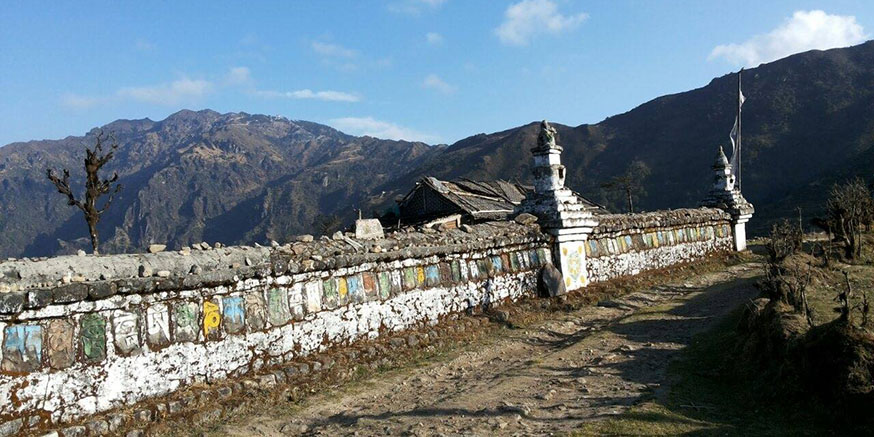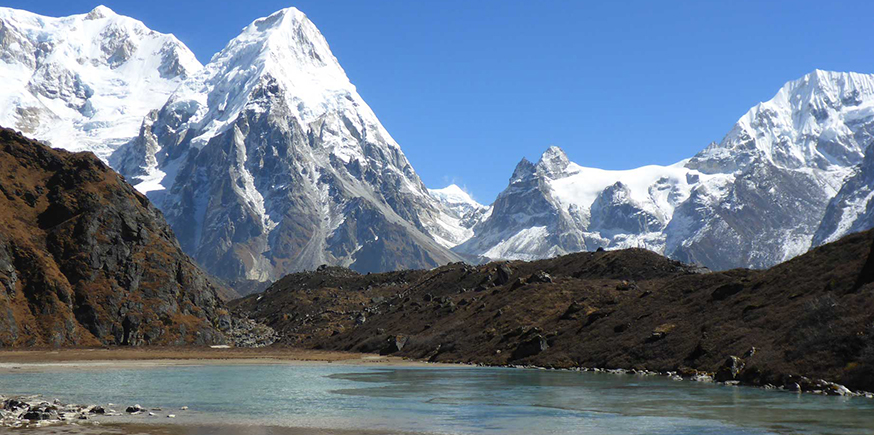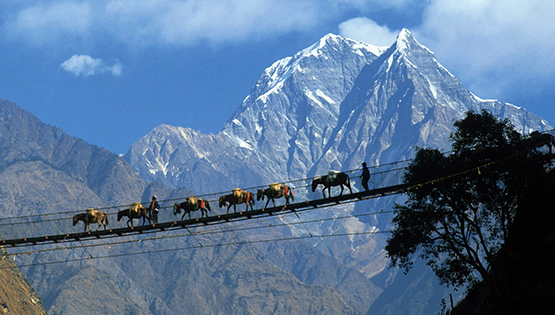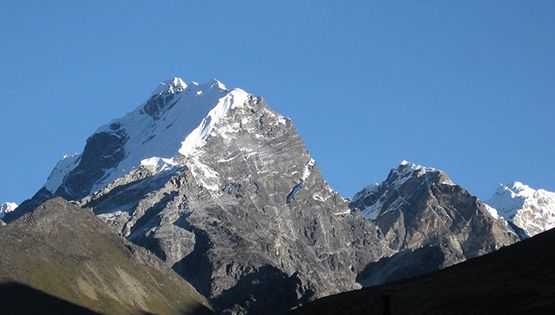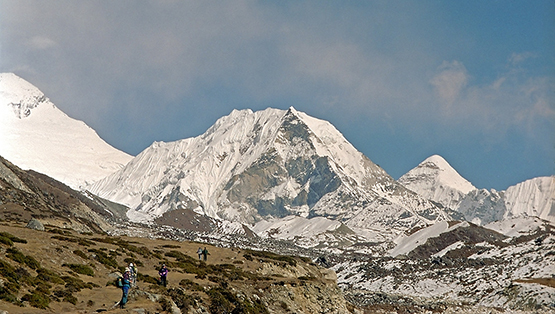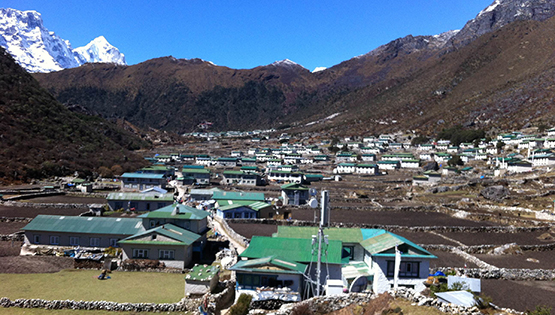Lumba Sumba Trek is one of the new trekking routes identified and explored by Trekking Agencies Association of Nepal (TAAN) in 2012. A 20-member team, including support staff, led by Rana Bahadur Khadka, 1st vice-president of TAAN, explored the route in April. Lumba Sumba Peak (5200m) is the major attraction of this route. Offering some of the most spectacular Himalayan landscapes, this trekking route is home to different ethnic groups like the Limbus, Sherpas, Rai, Gurung, Magars, Newars and Tamangs. The trek runs through Kanchenjunga Conservation Area (KCA) in the eastern Himalaya. Trekkers can explore the traditional farming practices and see different birds and wildlife species, including the endangered snow leopard and red panda, from the route. There are a number of high mountain lakes in Olangchung Gola. Through this route, we explore two of Nepal's best preserved protected areas the Kanchanjunga Conservation Area and the Makalu Barun National Park. Through the route, one can also trek to the base camps of Mt Kanchanjunga and Mt Makalu. Similarly, the Tamor and Arun River systems can be the other attraction for tourists. These two rivers are the major tributaries of the mighty Sapta Koshi River. The route encompasses alpine grass lands, rocky outcrops, dense temperate and sub-tropical forests, and low river valleys. Apart from natural beauty, trekkers can also explore cultural heritage like monasteries, chhortens, temples and prayer walls. And to add to the flavor, the festivals of all of these people living in harmony only serve to make the native culture livelier.
A very warm welcome to the Kingdom of Himalayas. Upon your arrival at the Tribhuvan international airport our representative welcomes you and assists you transfer in your hotel in Kathmandu. After time to get refreshed, evening you'll meet and transfer for welcome dinner in one of the typical Nepalese restaurant in the heart of Kathmandu i.e. Utsav or Nepali Chula (Kitchen). Here you will not simply experience the traditional Nepalese dish but will be entertained with Nepalese traditional dance and folk songs. After the dinner, you will be transferred back to your respective hotel.
Kathmandu is the historical and cultural heart of Nepal and has been a popular destination for tourists ever since Nepal opened its doors to visitors. The city presents a wonderful mix of Hinduism, Tibetan Buddhism and Western influence in the Valley. Bauddhanath: Stupa with its’ 130 ft. dome. One of the world's largest Stupa, Bouddha is generally acknowledged to be the most important Tibetan Buddhist monument outside Tibet. Tibetans simply call it CHORTEN CHEMPO "Great Stupa". It has now become the Mecca of Tibetan exiles in Nepal. Walking around Bouddhnath one often fins men wearing long braids wrapped around their heads. Many of these pilgrims carry their own prayer wheels, which they spin incessantly. Pupshupatinath Temple: Pashupatinath is considered one of the holiest shrines of all the Hindu temples. The temple has remained the presiding deity of ruling Nepalese Royalty. Located on the banks of the Bagmati river, this two-tiered magnificent golden temple with four triple silver doorways is unique example of the Nepalese temple architecture. It is one of the largest Hindu temple complex in' South Asia with hundreds of Shiva lingams, shrines icons of various Hindu god and goddess insides. This temple site occupies an area of 281 hectors in total. The main entrance of this temple is in the western side facing a small street of Deopatan market. As non-Hindus are not allowed to enter this temple courtyard. They are advised to go on the other side of the river in the East to have a glimpse of the temple complex. In the middle of the spring (Feb. March) every year there occurs a festival called Shivaratri. The world Shivaratri means the holy night of Lord Shiva. On this day many devotees visit the Pashupati Nath temple and make the ceremonial fire. Most of the devotees spend the night offering prayers to Shiva. This festival attracts tens of thousands of pilgrims from India besides the locals. Historically pre-Christian era this temple seems to have its origin away back to the early Kirat period. Stone sculptures found in the vicinity support the antiquity of this place. This holy site is 6 km. east oil down town Kathmandu. Regular bus and taxi services are easily available from a city points. Swayambhunath: Three kilometres west of Kathmandu city complex locates the one of the world's most glorious Buddhist Stupas, it is said to be 2000 years old. Visitors often call it "Monkey Temple". The main structure brick and clay which supports a lofty conical spire capped by a pinnacle of copper gilt. There are the all-seeing eyes of Lord Buddha on the four sides of spire. Being situated seventy meter above the level of valley, the hill of swayambhunath is a mosaic of small Stupas and pagoda temples. Aside, in front of the temple, one of the famous goddess with the shrine of Ajima called "Harati Mata" is there. This temple of goddess believes to be famous in the way of tantric. Both the stupa of Lord Buddha and temple of a goddess are surrounded by other temples and Tibetan monasteries. Being located in the top level of valley, this place is famous for visitors for sightseeing. After the city tour, our guide or the company's manager will do the full briefing of the trek. They will also take the opportunity to check the members' personal equipment as the city bazaars and climbing shops will provide the last chance to correct any deficiencies. We'll get organized with the complete expedition documentations today.
It's an early morning flight from Kathmandu Domestic Airport to Biratnagar. If there is availability of flight to Suketar for tomorrow, then you spend the night in Biratnagar and fly to Suketar the next morning. If there are no flights available to Suketar for tomorrow then, you drive to Phidim and spend the night there. Overnight in local hotel.
It's a 40 minutes flight to Suketar if there is a flight available. But if you have spent the night at Phidim in case of no flight from Biratnagar to Suketar, then you drive to Suketar. We will meet our porters and the rest of the trekking crew here and we spend the night at Suketar/Taplejung. Overnight in camp/Lodge.
The first day trek starts from Fungling (1777m)the headquarters of Taplejung district. Sherpa Tol is the gateway to this trek. The trek passes through beautiful cardamom fields and Alnus trees (Uttis) until Hangdewa VDC which takes around two and half hours. On the way, there are small tea shops at Asangpati Tole, Gaigode Tole and Panisar Tole that can be used for alternative accommodation as they provide home stay facilities. From Panisar, the trek is downhill until the suspension bridge that acts as a border between Hangdewa VDC and Furumbu VDC. A walk of 10 minutes takes us to Pawa Village (1546m) for lunch. After lunch, the trek progresses along the banks of Tamor River to Mitlung – a walk of around two hours. Mitlung (909m) is our destination for the day as it has good camping sites with facilities like kitchen and dining hall.
The trek passes along the banks of Tamor River on the second day. It is a pleasing walk until Furumbu – a 40 minute walk from Mitlung. From Furumbu, the trail is uphill for half hour then descends through Ulnus and Schima wallachiana mixed forest to Siwa Bazar (980m) at Linkhim VDC. We can reach Siwa Bazaar in three hours from Mitlung. Siwa Bazar is a good place for lunch. It is a small market with facilities like drug store, groceries and a police station. After lunch, the trek runs along the Tamor River until Tawa Village. Tawa Village (1170m) has a small tea shop. The trek runs uphill from here until we reach the KCAP Entrance Gate (1300m) at Thiwa Village. From here, the trek gradually descends until Chiruwa – our destination for the day. Chiruwa (1270m) is a small market with couple of lodges and good camping sites. It is a popular stopover for tourists and locals alike.
This day also the trek runs along the mighty Tamor River. At the start of the trek, there are two big stones with religious significance. The trek passes through Ulnus trees passes until we reach a big landslide that takes around half an hour to cross. After a walk of two and half hours from Chiruwa through beautiful cardamom gardens, we reach Tapethok (1380m) for lunch. It is a small market with some tea shops. There is also a KCAP checkpoint at Tapethok. After lunch, it is a pleasing walk for about an hour until Pembu (1486m). From Pembu, it is an uphill climb for about two and half hours to Lelep (1695m) our destination for the day. The KCAP headquarters is in Lelep. Similarly, there is a police station, some tea shops, groceries and hotels. There are also some good camping sites in Lelep.
After breakfast, the trek runs along the bank of Tamor River through dense forest that offers good habitat for different wildlife species. You can see some wild species if you are lucky. We crossed a suspension bridge after a walk of about an hour from Lelep. After crossing suspension bridge, it is an uphill climb through pine forest for about half an hour until we reach a monastery. From there, the trek gradually descends after about half an hour and we reach Gowatar (1806m) for lunch. Gowatar is a small settlement with a few houses. Near the village, there is a big stone and it is believed that only the religious people can move them. After a walk of around half hour from Gowatar, we reach a place that offers spectacular views of two waterfalls about 100 meters tall. A walk of about half an hour form here takes us to Phedi. After crossing Tamor River, it is an uphill climb for about 40 minutes until we reach a resting place known as chautaro in local dialect. Another 20 minutes walk will take us to our camping site at Ela Danda (2051m). The place offers panoramic view of snowcapped peaks including the Small Kasturi Peak and Tamor River.
The walk on the fifth day is pleasing as it passes through Ulnus and Rhododendron forest for about an hour until we reach a suspension bridge. After crossing the suspension bridge, the trek passes through dense bamboo groves (spread over around 5 hectares). This place is popular among trekkers as the habitat of red panda. If you are lucky, we might catch a sight of red panda from the trail itself. After a total walk of three and half hours from El Danda, we reach Maguwa (2435m) for lunch. After lunch, the trail passes through maple and Ulnus forest. There is a big landslide on the way and trekkers must be careful while crossing it. After a walk of about one and half hour, we reach Selep Kharka (2525m) – our destination for the day.
The sixth day’s trek runs along the banks of Tamor River leading to a place called Jongim (2641), a flat land surrounded by snow capped hills, after a walk of about an hour. Another 40 minutes walk through rhododendron forest from Jongim, takes us to a suspension bridge. After an uphill walk of about an hour from the suspension bridge, we reach Ramite (2685m) for lunch. At Ramite, we can see mixed forest of Deodar and rhododendron. We see a beautiful waterfall after a walk of about an hour from Ramite. If you are lucky, you might be rewarded with the view of red panda from here. We caught the first glimpse of Olangchung Gola after a walk of around 45 minutes from the waterfall. After a climb of about 40 minutes, we finally reach the camping site at Olangchung Gola (3208m). Olangchung Gola is a beautiful Sherpa village with around 45 houses, a 465 years old monastery with golden manuscript and KCAP office. There is also a sub-health post, a primary school and a border police station at Olangchung Gola.
The trek in the next three days will pass through complete wilderness. As the trek is in complete wilderness, it is better to hire a local Sherpa to avoid getting lost. However, piles of stones along the way act as sign posts, showing us our direction. The trek passes through pine and rhododendron forests. After a walk of two and half hours, we reach a place called Jadak (3636m) for lunch. A walk of three hours on snowy track will take us to our camping site at Upper Langmale (3893m).
The eighth day trek can be interesting as snow leopards have been sighted numerous times from this trek. The trek runs along the Tamor River and on the other side of the river lies dense rhododendron forest. After a walk of about three hours, we reach Yangetar (4203m) for lunch. Another three hours walk after lunch will lead us to our camping site at Pass Camp (4700m.
This would be the most difficult yet most memorable day of this trek. This day the trek will pass through the Lumba Sumba Pass (5177m). It is better to start early as it will be difficult to cross the peak after noon. The trek climbs a bit up and again runs down. It is better to take packed lunch, as there are no good camping sites around. After a walk of about four and half hour from Pass Camp, we climb the Lumba Sumba Peak and descend down to Chaurikharka (4594m) for night’s stay.
The trek is downhill from Chaurikharka as we come back to civilization after tiring walk for three days. After a walk of about three and half hours, we came across two roads – one to Lyasha in Tibet and the other toward Thudam. We prepared our lunch at this place. A walk of about three hours takes us to Thudam for the night’s accommodation. Thudam (3571m) is a small village with around 30 houses of Sherpa people
The eleventh day trek runs along the banks of Chujung Khola. The trail offers panoramic view of peaks in the Makalu range. On the way you see lot of small bushes and bamboo groves – the best habitat for red panda. If you are lucky, you can see this endangered species. It is better to carry packed lunch, as it is difficult to find drinking water along the trail. After a walk of about six-hours from Thudam, we reach Kharka (2877m) for the night’s halt.
The twelfth day’s walk passes through dense rhododendron forest. As there are no villages on the way and also there are numerous side trails, it is better to hire a local guide to avoid getting lost. After a walk of about three hours form Kharka, we reach a place called Chaurikharka for lunch. From Chaurikharka, we can clearly see Chyamtang (2229m), Arun River, Ridha Village and the road that leads to Kimathanka. After lunch, the trek is all downhill for about three hours until we reach Arun River. After crossing the suspension bridge over the Arun, the trek is uphill for about an hour until Chyamthang – our destination for the day. Chyamthang (2229m) is a small yet beautiful village with stone houses. Sherpas are the dominant population in the village.
The trail on the day passes through rhododendron forest. The walk is easy as chirping of birds make you feel refreshed. The trail is one of the popular places for birding as we are entering Arun Valley that is home to several bird species. A walk of about two and half hours from Chyamthang takes us to Gimber Village (2203m) for lunch. Gimber Village offers spectacular view of snowcapped peaks in the Makalu range. From Gimber, the walk is easy and after a trek of about three hours we reach Hatiya (1585) for the night’s stay. Hatiya – a small village of Bhote people – is the entry point to the Makalu National Park.
The trek on the 14th day runs along the banks of Arun River. After a walk of about two and half hours from Hatiya, we reach the confluence of Arun and Barun rivers. After having lunch near the river confluence, the trek progress toward Gola – our destination for the day. A walk of around two and half hours after lunch takes us to our camping site at Gola. Gola is a very small village with only 12 houses. Sherpa, Rai and Tamang people reside here.
The trek passes through paddy fields on the 15th day a sign that we are at lowlands now. The walk is pleasing as the trail makes a short descent, but again makes a short climb. After a walk of about two and half hours from Gola, we reach Pathibhara (not to be confused with the Pathibhara temple in Taplejung district) for lunch. Pathibhara (1500m) is a small Gurung village with tea shops, groceries and some hotels. The trail after lunch passes through agricultural land and we can find plenty of water sources and small settlements along the way. We reach Gadhi (1120m) our destination for the day – after a walk of around three hours from Pathibhara. Gadhi (that means fort in Nepali language) is a place of great historical significance as Nepali Army fought bravely with invading Tibetan Army at this place and chased them away. Gadhi is a small village market with a health post, a school and a police station.
This is the last day of our trek. A walk of about two and half hours from Gadhidanda takes us to Num (1560m). From Gadhidanda, the trek is about an hour downhill till the Arun River. After crossing the river, an uphill climb of about one and half hour takes us to the Num village (1560m). As Num is linked with motorable road, we can hire a vehicle to Khandbari (1022m) – the district headquarters of Sankhuwasabha district. A drive of around 4-5 hours on dirt road takes us to Khandbari. From Khandbari, buses are available to Dharan or Biratnagar. Or you can take a vehicle to Tumlingtar airstrip and fly directly to Kathmandu.
We continue our drive to Biratnagar and fly back to Kathmandu. Overnight in hotel
Rest and relax at the hotel after such long strenuous trip. The day is also reserved as a contingency day due to flight delays or other unforeseen conditions. For those eager to see as much of Kathmandu as possible, an early start is worthwhile to visit the temples of Pashupatinath and Swayambhunath and districts of Bhaktapur and Patan. Durbar Square is also on the essential list, as is the shopping area of Thamel. In the evening you can have your last night in Nepal, enjoying the Nepali cultural dinner show or go out to Thamel.
Today is free or last minute shopping for souvenirs or gift to your family, friends or relatives for you until your departure flight/drive or to commence any extra trips or activities you may have booked with us. If departing, you'll be transferred to the International Airport for your departure flight to your onwards destination.
- Four night hotel accommodation in Kathmandu in Hotel Shankar, a 4 star category hotel. Breakfast is included. Accommodation is on a twin share basis.
- One day sightseeing tour in & around Kathmandu(largest Buddhist stupa in the world at Bouddha-nath, most important Hindu temple in the valley at Pasupati-nath & Monkey temple, the valley's oldest & most sacred shrine at Syambhu-nath).
- Domestic flight Kathmandu-Bhadrapur and Biratnagar-Kathmandu.
- A BUS Transportation from Kathmandu to Taplejung for local staff and all the supplies for the trek
- Transportation Bhadrapur to Taplejung private Mini bus/Land Cruiser/according to group size(In the event of bad weather, it is possible to drive to Taplejung direct from KTM)
- Trekking permit & all Conservations fees and government taxes.
- All pickup and drop transportation from airport to airport both domestic & international.
- Meals during the trekking period three times a day Breakfast/Lunch/Dinner tea/coffee/hot drinks. Prepared by our well trained Nepali chef.
- Set of Oxygen, mask and regulator for medical use only.
- A comprehensive medical kit.
- An experienced Sherpa guide & appropriate number of Sherpa staff.
- Appropriate number of porters.
- A well trained cook & appropriate number of Kitchen boys.
- Good quality two men tent with sleeping mattress. Tent will be on twin share during the trek
- Group dining tent with table /Chairs and solar light inside plus toilet and shower tents.
- Cultural celebration meal either at Nepali Chula restaurant or similar after the trek with all the local staff.
- All local staff & porters properly insured & equipped.
- Travel and rescue arrangements.
- Sat Phone (for an emergency use only)
- International & home country domestic airfares, transfers en route & excess baggage.
- Your personal insurance: Medical, mountain rescue cover and repatriation is obligatory.
- Your personal expenses e.g. Phone calls, Laundry, Alcoholic beverage, Mineral water.
- Main meal (Lunch & Dinner) in Kathmandu & Pokhara apart from celebration meal
in Ktm.
- Tipping to the guide & local staff.
- Your Nepal entry visa fee USD50 for single entry. (Can be obtained on arrival at the
Kathmandu airport)
- Extra night accommodation in Kathmandu because of early arrival, late departure,
early return from mountain (due to any reason) than the scheduled itinerary.
| # | Start Date | End Date | Trip Cost | Availability | Booking |
|---|---|---|---|---|---|
| 1 | 22/9/2024 | 14/10/2024 | $3550/PERSON | Available | Book Now |
| 2 | 31/3/2024 | 22/4/2024 | $3600/PERSON | Available | Book Now |
| 3 | 2/4/2024 | 24/4/2024 | $3600/PERSON | Available | Book Now |
| 4 | 15/10/2024 | 6/11/2024 | $3550/PERSON | Available | Book Now |
| 5 | 20/10/2024 | 11/11/2024 | $3600/PERSON | Available | Book Now |
| 6 | 30/9/2024 | 22/10/2024 | $3550/PERSON | Available | Book Now |
A deposit of 30% of the total trip cost is payable at the time of booking and the final balance due 6 weeks before the start of the trip. The act of booking implies that you have accepted the ethos of the trip and any objective or subjective risks associated with it.
- More than 42 days before departure 30% of total cost
- 42 to 29 days 50% of total cost
- 28 days to 15 days 75% of total cost and
- 14 days or less 100% of total cost.
